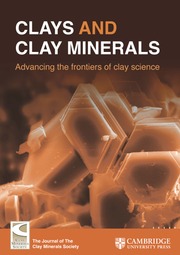Article contents
Preparation and Antibacterial Properties of Carvacrol-loaded Composite Microcapsules via Palygorskite-Stabilized Pickering Emulsions
Published online by Cambridge University Press: 01 January 2024
Abstract
Essential oils (including carvacrol, CAR) have been used in the medicinal and health field because of their broad-spectrum antibacterial activities. However, the volatility and pungent odor are still the greatest obstacles to wider application. The purpose of the present study was to address those problems by encapsulating the antibacterial CAR in palygorskite (Plg) by integrating it into Pickering emulsions with complex coacervation. The CAR in Pickering emulsion was formed firstly by stabilization with the CAR-modified Plg; then, the emulsion droplets were embedded and fixed in the microcapsule through the subsequent complex coacervation process, which occurred between the quaternary ammonium salt of chitooligosaccharides (HACC) and sodium alginate (SA) via calcium ions. The microcapsules obtained were characterized by Fourier-transform infrared spectroscopy (FTIR), scanning electron microscopy (SEM), and thermogravimetric analysis (TGA). The results demonstrated that the microcapsules presented a nearly sphere-like shape with a mean diameter of 3.5 mm but had a porous interior structure. The Plg plays multiple roles in the preparation process, including increasing the emulsion stability, improving the encapsulation efficiency of CAR, and the thermostability of microcapsules. The microcapsules showed remarkable antibacterial properties against Escherichia coli (E. coli) and Staphylococcus aureus (S. aureus), and inhibition rates toward E. coli and S. aureus reached 100% when the microcapsules were encapsulated with 15 or 20% of CAR, respectively. The microcapsules obtained could be used as antibacterial agents in food preservatives, animal feed, and other health-related consumer products.
Information
- Type
- Original Paper
- Information
- Copyright
- Copyright © The Author(s), under exclusive licence to The Clay Minerals Society 2022
Footnotes
Associate Editor: Lynda B. Williams
References
- 3
- Cited by

